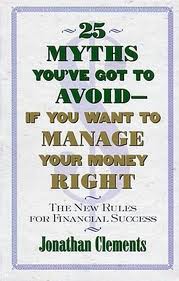When I started Bankers Anonymous, I decided I would not spend any time on “How to Invest” books, because I believed the whole genre unworthy of serious consideration. Instead, I would consider “How Not to Invest” books as decidedly more fruitful variations on a theme, warning readers about pitfalls and snake oil pitches in the books-on-investing world.
Since then, I’ve edged closer to reviewing on this site what most people would consider “How to Invest” books.
Jonathan Clements’ 25 Myths You’ve Got To Avoid If You Want To Manage Your Money Right barely qualifies under my original restrictive criteria for books I can review. But because he engages in a contrarian-style debunking of conventional investment wisdom – which I like – I’m going to offer him, and me, amnesty from my original rule.
What fun are personal blogging rules if you don’t break them, anyway?
Clements wrote the “Getting Started” personal finance column for the Wall Street Journal for many years, honing his writing chops for years on these topics. Clements published 25 Myths in 1998, just 3 years after Nancy Dunnan’s laughably anachronistic Your First Financial Steps, but by contrast his advice retains its freshness well past the ‘sell by’ date.
Each chapter tackles a conventional wisdom myth of personal investing with a mini-section titled “Where We Go Wrong,” followed by another mini-section titled “The New Rules.”
While admittedly some of these myths are really straw men – few people who’ve ever thought about the topic actually embrace the old myth being debunked – Clements’ method for teaching on the topic works well. Myth, Mistake, New Rule. Wash, Rinse, Repeat.
In sum, I recommend this book.
In the spirit of providing value-added services for Bankers Anonymous readers – value-added or your money back! – and because these are all thoughts worth thinking, I provide Cliffs Notes for Clements’ book.
Myth #1 – You can have it all
Reality – Few of us mortals can simultaneously pay off debt, save for an emergency fund, purchase a home, maximize retirement accounts, never carry a credit card balance, pay for college, and still have something left over beyond rice and beans every day. At least in the short run, you have to prioritize and make hard choices. Fair enough.
Myth #2 – Get a good job and you’ll be set for life
Reality – Nobody has job security anymore, pensions are few and far between, and few people spend all their working years with the same employer, or even in the same industry. This seems even truer today than it was when this book came out in 1998.
Myth #2 – Stocks are Risky
Reality – In the long run, not really. In the long run, bonds and money markets are risky because after taxes and inflation, they offer no real return. This is among Clements’ most controversial statements, and I couldn’t agree more, despite the fact that he published his book before both the tech crash of 2000 and the credit crunch of 2008. In fact, myth #3 is where I decided this was a book worth reading, as it agrees on this point and others quite closely with one of my absolute faves, Simple Wealth, Inevitable Wealth.
Myth #4 – You can’t go wrong with IBM
Reality – This myth is short-hand for the idea that any one company’s stock offers immunity from investing disaster and, despite the headline, Clements really focuses on Microsoft as the heralded ‘blue-chip’ of the 1998 time-period. In reality, any single company can go horribly wrong, and most individual investors would do better to focus on sector-investing in the equity markets, rather than stock-picking.
Myth #5 – You can beat the market
Reality – We are all the market, so ‘beating’ the market is both mathematically implausible for the majority of us, as well as empirically rare, and a red-herring of an investment goal. For me, this myth ranks as the biggest lie perpetrated on us by the Financial Infotainment Industrial Complex. The goal should not be to ‘beat’ the market, but rather to be exposed to the market, to achieve market returns.
Myth #6 – Your investment will make 10 percent a year
Reality – Here’s a bit of an anachronism from 25 Myths since few people in 2013 expect 10% returns from the stock market on a consistent basis. If Clements wrote this book in 2013 he’d have to make the myth: “Your investment will make 5 percent a year” just to make it a plausible straw man. On the other hand, memories are short, and we’ll have to forgive investors entering the field after 2009 for outlandish expectations. Don’t look now, but the damn market just more than doubled in the last four years. Pretty soon folks will think that’s the new normal. Double my money in just 4 years! Sweet!
Myth #7 – You can’t go wrong with mutual funds
Reality – Sector mutual funds can be terribly undiversified, expenses can be outrageously high, some investment managers still sell “load” funds, and minimum investment sizes can keep people out of the market, to name just a few flaws of mutual funds, broadly understood.
Myth #8 – You can find the next Magellen
Reality – Again, an anachronism. People under 40 don’t think of Peter Lynch’s fund –The first $billion mutual fund and easily the most famous mutual fund of the 1980s – when they think of investment rock-stars. Legg Mason’s Bill Miller overtook that crown in the 2000s, and hedge fund managers largely replaced mutual fund managers as the sexy geniuses touted by the Financial Infotainment Industrial Complex. Soros, Robertson, Jones in the 1980s and 90s, Tepper, Ackman, Loeb, Cohen, Einhorn, Eisman, Paulsen in the 2000 and 2010s. The point, however, is that few of us can realistically pick those winners before they were rock stars. Once they are rock stars, you’re either purchasing lagging returns (an error!), or you can’t actually get into the fund (quel domage!)
Myth #9 – Index funds are guaranteed mediocrity
Reality –Index funds outperform most actively managed funds over the medium to long run, mostly due to the latter’s higher fees and higher portfolio churn.
Myth #10 – Nothing’s safer than money in the bank
Reality – Clements recommends money market funds, with check-writing capabilities, as a higher-yielding opportunity than savings in a bank. At this point in the interest-rate cycle (zero return either way!), and with the unfortunate experience of money market funds ‘breaking the buck’ in 2008 without a government bailout, I’m less inclined than Clements to point out the advantages of money market funds over money in a bank. But, whatever.
Myth #11 – If you need income, buy bonds
Reality – To quote Clements: “Investors love bonds. It’s what you would call a sado-masochistic relationship. Bonds suck investors in with their fat yields, then bludgeon them with inflation, taxes, defaults, early redemptions and more. Yet folks keep coming back for more…What do I think? I think bonds stink.” The irony here is that I wholly agree with Clements despite two important situational facts: 1. I am a bond guy by training and fixed-income oriented in my investment outlook 2. At the time he published his book, bonds easily offered 6.5% US government-guaranteed yield, which any total-return-oriented equity investor would probably kill for today.
Myth #12 – Hedge your bet with hard assets
Reality – Clements points out that hard assets like real estate, precious metals, art, and collectibles should only reasonably return the rate of inflation over the medium and long run. Despite my arguing in favor of home ownership as a particularly advantageous hard asset investment, I agree with his expectations-setting of price appreciation when it comes to hard assets.
Myth #13 – You should own a balanced portfolio
Reality – In this context, Clements means ‘balanced’ as a 60/40 split between stocks and bonds. Clements points out, rightly, that many individuals would benefit from a more equity-oriented mix, and the specific 60/40 traditional blend doesn’t work for everyone. Fair enough. Although to pick a fight with him and myself at the same time: While 60/40 may not be the answer to everybody’s needs, there are also much worse ways to allocate your investments. Any individual investor should probably deviate meaningfully from 60/40, but if you were to mandate an allocation that everybody has to follow, 60/40 isn’t a terrible place to start. It’s not right for me, for example, but it wouldn’t completely screw me up either, as much as other potential allocations might. To pick another fight, only with Clements this time, he’s overly proscriptive and enamored with zero coupon bonds for investors. I get where he’s coming from, but I certainly wouldn’t send any individual out to buy zero coupon bonds today.
Myth #14 – You need a broker
Reality – Discount/low-service/online brokerages may be just fine for the do-it-yourself generation, even more true now than it was when 25 Myths first came out. Clements wisely points out, and I concur, that a good investment advisor offers timely hand-holding when the shit inevitably hits the fan in your stock portfolio. Their value-added is to get you to do nothing, because you made a reasonable plan, and now you need to be tied to the mast, and not allowed to sell out your equities at the bottom. That is the true value of an investment advisor.
Myth #15 – Keep six months of emergency money
Reality – Few people can do this, and credit cards, home equity lines, or even non-retirement equity accounts may serve this purpose for many people and under many conditions.
Myth #16 – Debt is dangerous
Reality – Of course it is dangerous. But it may be better than the alternative of not using debt, such as never owning a car, never going to college, always renting your home, or keeping too much cash earning zero return. He points out the advantages available in stock margin accounts (too scary for me!) and home equity lines of credit, which I highly endorse under certain scenarios.
Myth #17 – Buy the biggest house possible
Reality – You can lose a lot of money buying a home as everyone re-learned, again, in 2008, because investing in housing is quite risky. Clements supplements this chapter with wise thoughts on housing as an inflation-hedge and as a form of forced savings, which influenced my post on the advantages of housing as an investment.
Myth #18 – You can’t beat the mortgage tax deduction
Reality – Clements argues correctly that having a large mortgage ‘for the deduction’ is not clever but asinine. You end up spending $1 to save 15 cents. “Spend to save” is such a large part of our advertising and consumption culture that I’m not surprised the Financial Infotainment Industrial Complex has convinced so many of us of this ‘wisdom,’ but still.
Myth #19 – Invest in your house
Reality – Houses can be huge money pits, in which we convince ourselves that spending money on the structure for consumption purposes may be mistakenly considered an ‘investment.’ As Clements points out, the home improvement industry brags:
you might recoup 95% of the cost of a minor kitchen remodeling, 91% of a bathroom addition, 83% of a family room addition, 77% of a bathroom remodeling, and 72% from adding on a deck.
Using those numbers, in investment terms, you lose between 5% and 18% on the ‘investment,’ which makes it a terrible investment indeed. It’s fine as an act of consumption, of course, but a loser as an investment. The lesson: You’ve got to separate the consumption and investment functions when spending money on your house.
Myth #20 – Trade up as soon as you can
Reality – Trading up in terms of house size or price ‘as soon as you can’ can cost you somewhere between a lot to everything, as anyone with a pulse, watching the 2008 credit crunch, realizes.
Myth #21 – Protect against every disaster
Reality – Clements and I sing from the same hymnal here, in that many people purchase more insurance than needed. If it ain’t risk transfer, it ain’t insurance worth buying. (Apparently our mutual hymnal speaks in a terribly uneducated manner.) In addition, some insurance is optional at best, useless and expensive at worst.
Myth #22 – Life Insurance is a good investment
Reality – I could kiss Clements. It’s like his chapter lines up perfectly with my previous blog postings on life insurance as a useful risk transfer but a terrible investment. Honestly, I wrote these things before reading his book.
Myth #23 – Invest in your kids’ name
Reality – Apparently this must have happened back in the 80s and 90s as a tax dodge. I never hear about anyone doing this nowadays. Maybe the parents I know are just poorer than the New York City-based parents Clements interacted with. Or maybe parents today learned too much from the 1980s, and Studio 54, and how a lifetime of parental investments can be snorted through your child’s nose. Anyway, in case you’re tempted, Clements doesn’t recommend this.
Myth #24 – Max out your IRA every year
Reality – Clements wants you to know that retirement-account funds are semi-permanently locked up, they change the eventual taxable nature of your retirement income to capital gains, you might have tax hassles, and you still pay taxes upon death. I suppose he’s right, but for most of us it’s still a worthy aspiration to max out our IRA. It’s unlikely, but you might miss out on a Mitt Romney type situation if you don’t max out your IRA – especially a self-directed IRA – and Roth IRAs have special powers on which Clements does not elaborate. So I mostly disagree with Clements on this ‘myth.’ Let’s move on.
Myth #25 – One day, kids, all of this will be yours
Reality – Estate planning takes a lot of work, and it is available to folks who invest a lot of time and some money in the project. He urges careful organizing, talking as openly as possible with heirs, and remaining alert to the opportunities for giving tax-free. Fair enough. I’m not there in my life yet to have done much thinking about this, beyond paying an attorney to prepare a simple will.
If you made it this far, congratulations. You don’t necessarily need to buy the book, but you could click through to it anyway and make a different purchase. That way I can track your purchase and write a funny note about what Bankers Anonymous readers like to buy. Would somebody please buy that Hutzler 571 Banana Slicer?
Please see related post: All Bankers Anonymous Book Reviews in one place.
Post read (14542) times.






